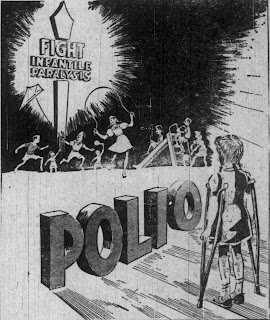Most people know that the March of Dimes is a nonprofit foundation that "leads the fight for the health of all moms and babies." But do you know why this organization was founded? It began as the National Foundation for Infantile Paralysis, founded by President Franklin D. Roosevelt in 1938, to combat polio.
Like many viruses, the poliovirus has existed for centuries, with the first clinical description of the disease appearing in 1789. The first polio epidemic outbreak in the United States occurred in 1894. By 1905, the contagious nature of poliomyelitis was discovered, and a few years later, scientists discovered the disease was caused by a virus.
Most polio victims were children under ten; only one-fifth of all reported cases were in people 15 years of age and older. Seventy-five years ago, the poliovirus, also known as infantile paralysis, was the most feared disease in the U.S. Late summer intensified this fear as it was dubbed "polio season."
Every year at this time, the annual nationwide March of Dimes fundraising campaign is held. The time coincided with President Roosevelt's birthday, and the idea was to show the President that the people were with him in the fight against polio. Across the nation, committees and chapters were formed promoting the fundraiser.
In 1940, the Bossier Parish superintendent of schools, R.V. Kerr, served as chairman of the fundraising drive. Civic groups like the Benton Lions Club sponsored local events. In 1946, Bossier City held its first March of Dimes campaign, which came to close with the President's Birthday Ball, a common feature of the annual fundraiser seen across the nation.
 |
| Bossier City March of Dimes drive, c 1946. James Allen Collection: L043 |
The road to a vaccine was long during that time, without the scientific knowledge and technology we have today. At its peak in the 1940s and 1950s, polio would paralyze or kill over a million people worldwide every year. By the 1950s, polio had become one of the most serious communicable diseases among children in the U.S. Every year Bossierites organized and ran March of Dime drives. Mayor Burgess proclaimed January 1956 as National Polio month.
Through the work of volunteers, money raised by the March of Dimes supported research and education efforts, serving as an alliance between scientists and volunteers. The March of Dimes pioneered the polio vaccine research, making it possible to develop the Salk vaccine. Polio vaccine filed trials sponsored by the March of Dimes in 1954 at select locations nationwide. Bossier Parish was one of four parishes in Louisiana to participate in these trials, dubbed the greatest public health experiment in history.
After successful trials, vaccination clinics were held the following year. Efforts were slowed by vaccine shortages, but by 1957, the annual number of cases was reduced by over 90% following mass immunizations promoted by the March of Dimes. With a safe and effective vaccine, the dedication of health workers, and parents who vaccinate their children on schedule, the poliovirus was eradicated from the United States in 1979.
By: Amy Robertson



No comments:
Post a Comment